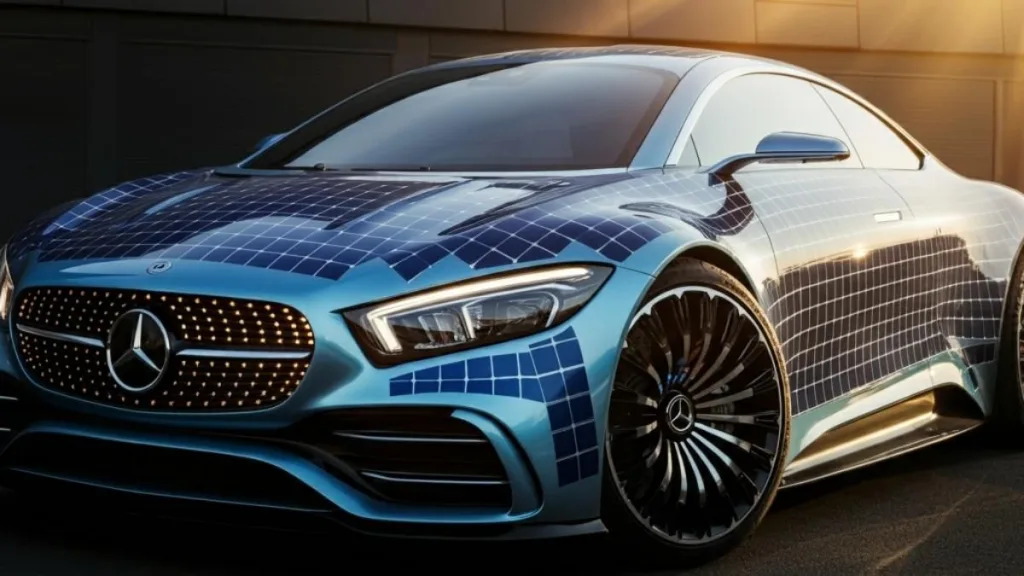Mercedes-Benz Develops “Solar Paint” for Electric Cars

Mercedes-Benz, one of the global pioneers in automotive technology, has unveiled a groundbreaking development – solar paint technology designed specifically for electric vehicles (EVs). This innovative approach promises to redefine energy efficiency and sustainability in the automotive industry, aligning with the brand’s commitment to environmental responsibility.
What Is Solar Paint and How Does It Work?
Solar paint is a novel material integrated with photovoltaic cells capable of converting sunlight into electrical energy. This advanced coating is applied directly to the vehicle’s exterior, allowing the car to generate electricity while exposed to sunlight. The energy collected can be used to charge the battery or power auxiliary systems, reducing dependency on traditional charging methods.
The concept of solar paint leverages advancements in nanotechnology to create a seamless solution for energy generation. Each particle in the paint is engineered to capture solar energy with precision, ensuring optimal efficiency regardless of weather conditions. This level of sophistication highlights the potential of solar paint to become a standard feature in future EV designs.
Additionally, Mercedes-Benz’s solar paint boasts a visually appealing finish, demonstrating that functionality and aesthetics can coexist. The integration of this technology aligns perfectly with the company’s vision to provide luxury solutions without compromising on sustainability. By integrating solar energy capture into the vehicle’s design, Mercedes-Benz sets a precedent for the industry to follow.
The Science Behind Solar Paint
The technology involves a blend of nanomaterials and light-sensitive compounds engineered to maximise energy conversion efficiency. Unlike traditional solar panels, solar paint seamlessly integrates with the car’s surface without adding extra weight or altering its aerodynamics. This innovation ensures that every square inch of the car contributes to its energy efficiency.
One of the standout features of solar paint is its adaptability to various car models and shapes. Engineers have ensured that the paint adheres to different surfaces without compromising its performance. This flexibility means that future iterations of solar paint can potentially extend beyond automotive applications, such as in aviation or maritime industries.
Moreover, the durability of solar paint is a critical focus in its development. Researchers at Mercedes-Benz are testing the material under extreme weather conditions to ensure its long-term viability. Whether it’s intense sunlight, freezing temperatures, or heavy rainfall, the solar paint is being fine-tuned to maintain peak performance in diverse environments.
Advantages of Solar Paint for Electric Cars
The introduction of solar paint could address key challenges faced by EV owners, such as range anxiety and limited charging infrastructure. By harnessing solar energy, vehicles equipped with this technology can achieve greater autonomy and offer enhanced convenience to users.
One of the most compelling benefits is its ability to charge the battery during commutes or when parked outdoors. This constant energy replenishment reduces the need for frequent charging stops, making long-distance travel more practical for EV users. Solar paint is not just a convenience—it’s a step towards greater energy independence.
From an economic perspective, solar paint has the potential to lower overall ownership costs for EVs. By generating a portion of their energy needs, owners can cut down on electricity bills and reduce wear on traditional charging systems. This dual advantage makes solar paint a practical and innovative solution for modern transportation needs.
Economic and Environmental Impact
Beyond individual benefits, solar paint aligns with broader environmental goals. It reduces reliance on non-renewable energy sources and decreases carbon emissions associated with EV charging. Additionally, the potential cost savings for consumers could make EVs a more attractive option for a wider audience, accelerating the transition to greener transportation.
The environmental implications are profound. With widespread adoption, solar paint could significantly lower the automotive sector’s carbon footprint. It directly contributes to global sustainability targets, making it an essential innovation for a cleaner future. Mercedes-Benz’s commitment to eco-conscious technology ensures its leadership role in driving sustainable change.
Furthermore, the use of renewable energy sources like solar paint underscores the importance of integrating environmentally friendly practices across industries. By setting an example, Mercedes-Benz encourages other manufacturers to invest in green technologies, fostering an ecosystem of innovation and responsibility.

Future Prospects of Solar Paint Technology
While still in the prototype phase, Mercedes-Benz’s solar paint technology is already generating significant interest across the automotive industry. Experts predict that this innovation could soon extend to other applications, such as residential energy solutions and commercial fleet management. Its scalability and versatility make it a promising development for the future of sustainable technology.
The broader implications of this innovation are particularly exciting. Imagine homes and buildings painted with similar solar coatings, generating electricity directly from their walls. This vision of a fully solar-powered infrastructure could transform urban planning and energy distribution on a global scale.
Moreover, partnerships with renewable energy experts and academic institutions are expected to accelerate the development and adoption of solar paint. Mercedes-Benz has a history of collaborative innovation, and this project is no exception. By pooling resources and expertise, the company aims to refine solar paint for mass production within the next decade.
Challenges and Next Steps
Despite its potential, implementing solar paint at a commercial scale poses challenges, including production costs and durability in varying climates. Mercedes-Benz is actively working on refining the technology to overcome these hurdles and bring solar paint to market in the coming years. Strategic collaborations with renewable energy experts and material scientists will play a crucial role in this endeavour.
To address cost barriers, Mercedes-Benz is exploring advanced manufacturing techniques that streamline production without compromising quality. Additionally, rigorous testing is being conducted to ensure that solar paint meets safety and efficiency standards. These efforts demonstrate the company’s commitment to delivering a reliable and groundbreaking product.
Ultimately, the success of solar paint will depend on its reception by consumers and industry stakeholders. Early adopters, combined with supportive regulatory frameworks, will play a vital role in its widespread implementation. Mercedes-Benz’s continued investment in innovation ensures that this technology remains at the forefront of sustainable transportation.
